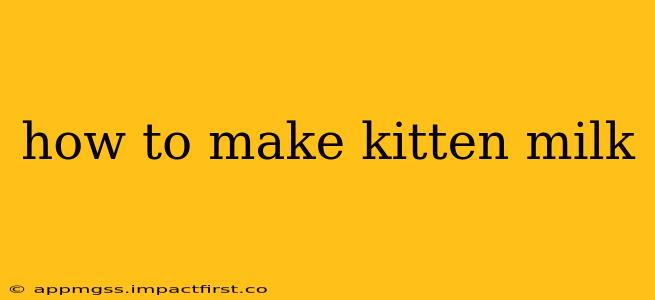Congratulations on welcoming a new kitten into your home! Providing proper nutrition is crucial for their health and development, especially if they've been separated from their mother too early. While commercial kitten milk replacer (KMR) is always the recommended option, understanding how to prepare it correctly is vital. This guide will walk you through the process, addressing common questions and concerns.
Why Use Kitten Milk Replacer (KMR)?
Cow's milk is not suitable for kittens. It lacks the essential nutrients and can cause digestive upset, diarrhea, and even death. Kitten milk replacer is specifically formulated to meet the nutritional needs of young kittens, providing the right balance of proteins, fats, carbohydrates, and essential vitamins and minerals for healthy growth.
What You'll Need to Make Kitten Milk
Before you begin, gather the necessary materials:
- Kitten milk replacer (KMR): Choose a high-quality brand from a reputable pet store. Read the instructions carefully, as preparation methods may vary slightly between brands.
- Clean bottle and nipple: Sterilize these thoroughly before each use. You can boil them for 5-10 minutes or use a bottle sterilizer.
- Warm water: Use bottled or filtered water to avoid potential contaminants. The water temperature is crucial; it should be lukewarm, not hot.
- Measuring spoons and cups: Precise measurements are essential for proper nutrition.
- Clean bowl: For mixing the KMR.
How to Mix Kitten Milk Replacer (KMR)
The exact ratio of water to powder will be specified on the KMR packaging. Always follow the manufacturer's instructions precisely. Generally, you'll mix the powder with warm water until it forms a smooth, creamy consistency similar to breast milk. Avoid lumps.
Step-by-step instructions:
- Boil water: Bring filtered or bottled water to a rolling boil for one minute to sterilize.
- Cool the water: Allow the boiled water to cool until it reaches a lukewarm temperature (around 100-105°F or 38-40°C). Testing the temperature on your wrist is a good way to ensure it's not too hot.
- Add powder: Gradually add the KMR powder to the warm water, stirring continuously to prevent lumps.
- Mix thoroughly: Continue stirring until the mixture is smooth and creamy.
- Check the temperature: Test the temperature again to ensure it's still lukewarm.
How Often Should I Feed My Kitten?
The feeding frequency depends on the kitten's age and size. Very young kittens (newborn to a few weeks old) may need to be fed every 2-3 hours, while older kittens can be fed less frequently. Refer to your vet's guidance or the instructions on your KMR packaging for a detailed feeding schedule.
How Much Should I Feed My Kitten?
The amount of milk per feeding will also depend on the kitten's age and size. Your veterinarian can provide the most accurate guidance on the appropriate amount of milk for your kitten. Never overfeed.
What if My Kitten Refuses to Eat?
If your kitten is reluctant to eat, try the following:
- Adjust the temperature: Ensure the milk is lukewarm, not too hot or cold.
- Try a different nipple: Some kittens prefer different nipple types.
- Stimulate the kitten: Gently massage the kitten's belly or rub its cheeks to encourage feeding.
- Consult your veterinarian: If your kitten continues to refuse food, seek veterinary attention immediately.
What if My Kitten Has Diarrhea?
Diarrhea can be a serious issue in kittens. If your kitten experiences diarrhea after consuming KMR, stop feeding it immediately and consult your veterinarian. This could indicate a problem with the KMR, an underlying health issue, or an incorrect mixing ratio.
Can I Make Kitten Milk Without KMR?
No, you should never attempt to make kitten milk using household ingredients like cow's milk or goat's milk. These are unsuitable for kittens and can lead to severe health problems. Always use a commercially available, high-quality kitten milk replacer.
When Can I Wean My Kitten?
Weaning should be a gradual process, typically starting around 4 weeks of age. Introduce solid kitten food alongside KMR, gradually reducing the amount of KMR over several weeks until your kitten is completely weaned onto solid food. Consult your veterinarian to determine the best weaning schedule for your kitten.
Remember, this information is for general guidance only. Always consult your veterinarian for personalized advice on feeding your kitten. Early veterinary care is crucial for a healthy and happy kitten!
